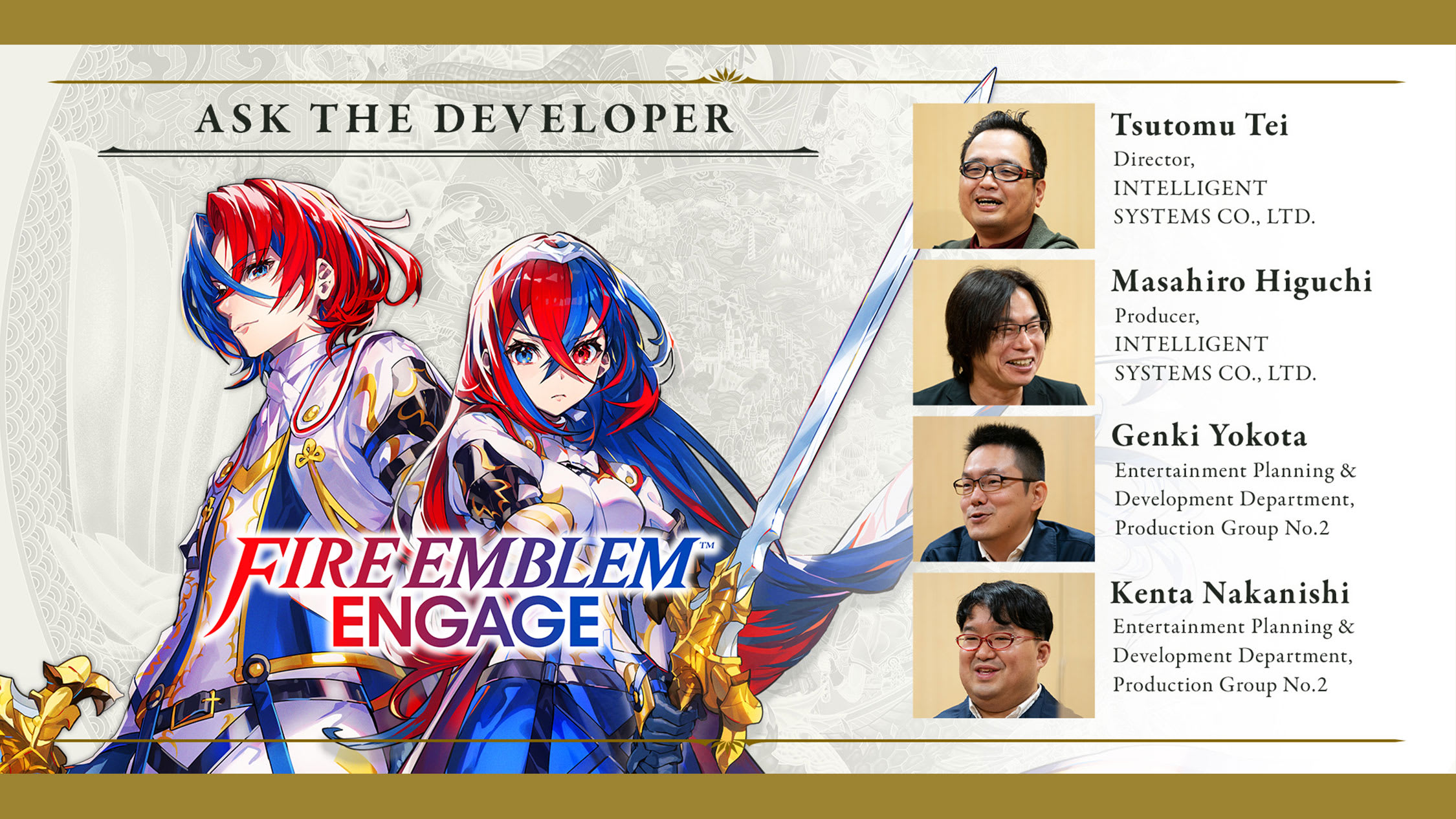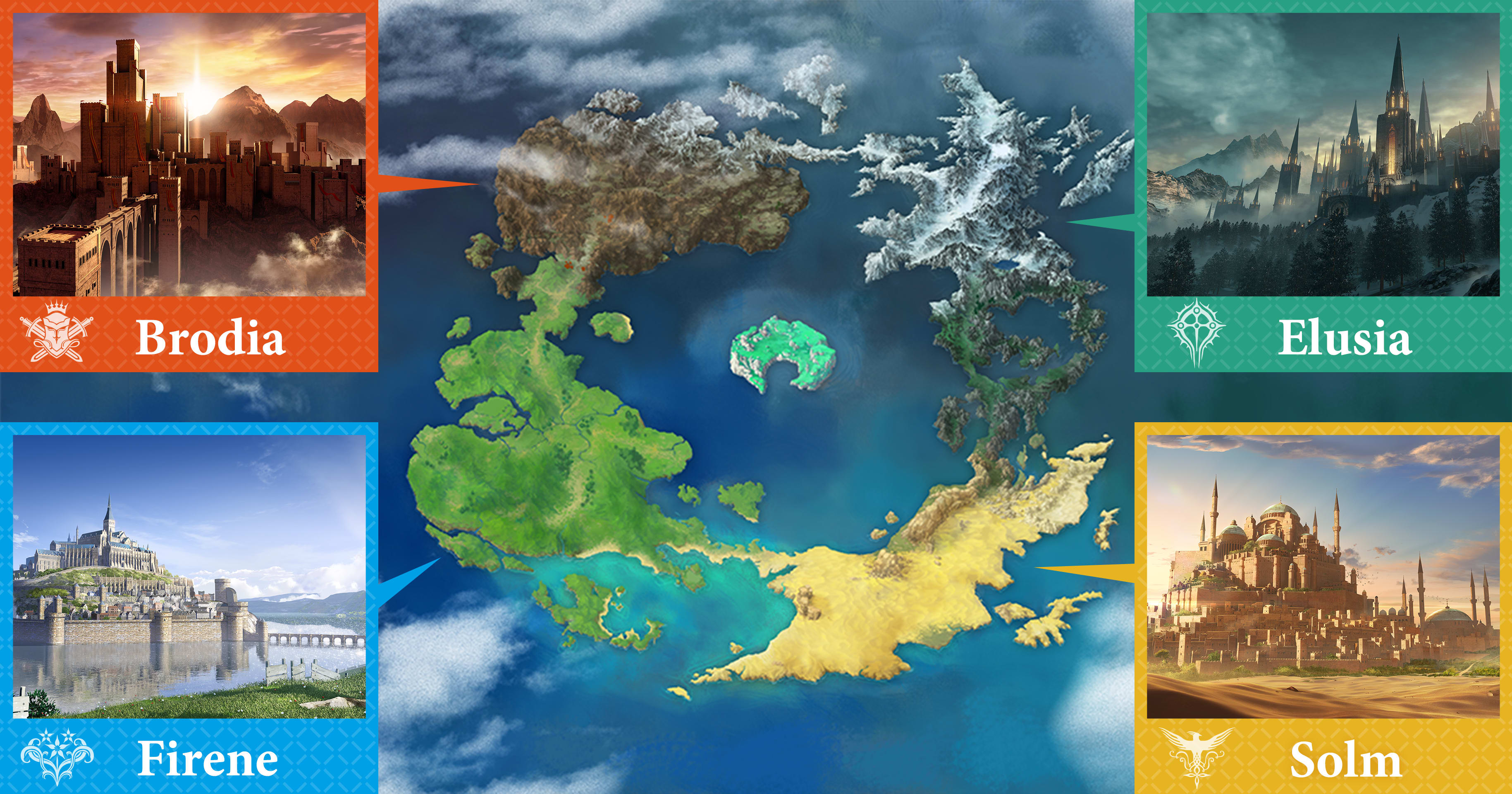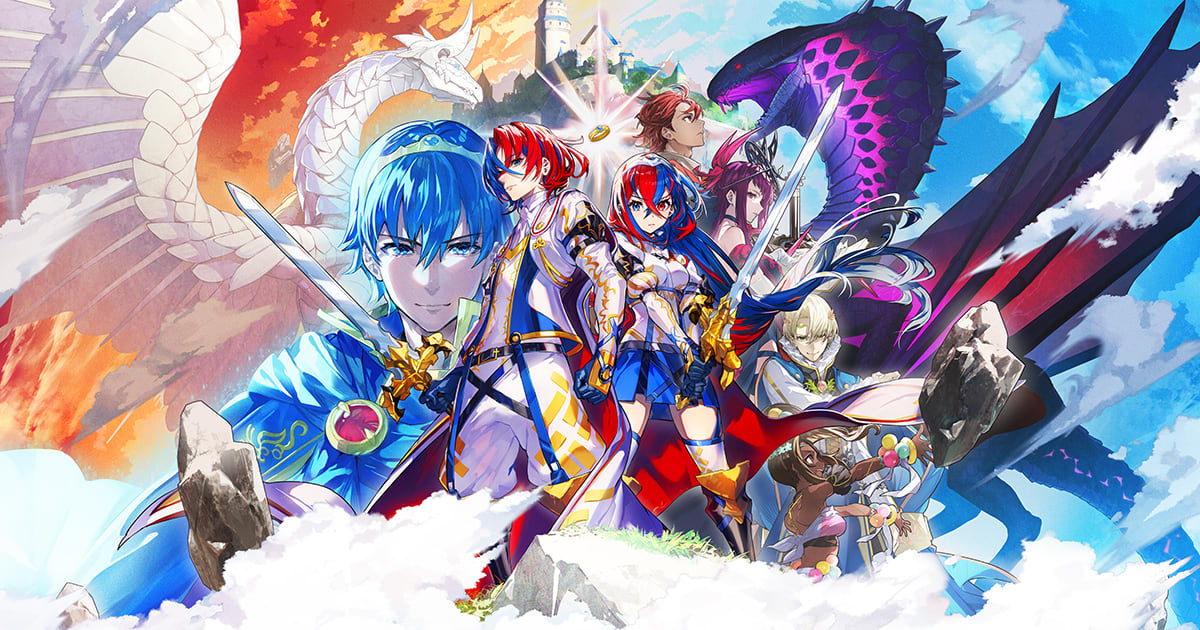
Ask the Developer Vol. 8, Fire Emblem Engage—Part 1
Content pre-recorded in accordance with current COVID-19 health and safety guidelines.
This article has been translated from the original Japanese content.
The images shown in text were created during development.
In this eighth volume of Ask the Developer, an interview series in which Nintendo developers convey in their own words Nintendo's thoughts about creating products and the specific points they are particular about, we're talking to developers behind the Fire Emblem™ Engage game for the Nintendo Switch™ system, launching on Friday, January 20.
Check out the rest of the interview:
Part 1: Motivating players to give Fire Emblem a try
We are pleased to have members of Intelligent Systems (1) here at Nintendo headquarters for today’s interview. Tei-san and Higuchi-san, could you briefly introduce yourselves?
Tsutomu Tei (referred to as Tei from this point on): Hi! I’m Tei from Intelligent Systems. As a director for this title, I was in charge of making decisions from setting the theme to deciding the general direction of the game.
Masahiro Higuchi (referred to as Higuchi from this point on): Hi, I am Higuchi, also from Intelligent Systems. I’ve been involved in the series as a developer since Fire Emblem: Genealogy of the Holy War (2), released in 1996 in Japan, and I’ve been joining the development as the producer since Fire Emblem Fates (3), released in 2015 in Japan (2016 in the U.S.).
(1) Intelligent Systems Co., Ltd.: A company that has developed Nintendo games, including the Fire Emblem and Paper Mario series. They have also created software development support tools for Nintendo systems. Headquartered in Kyoto. Nickname: IS, pronounced like the word "is."
(2) Fire Emblem: Genealogy of the Holy War: A game released in May 1996 for the Super Famicom exclusively in Japan. The Super Famicom was released in Europe and North America as the Super Nintendo Entertainment System (Super NES). The feature in which the relationships among the parent generation characters influence the child generation characters became a popular topic of conversation among players.
(3) Fire Emblem Fates: A game released in February 2016 for the Nintendo 3DS family of systems.The story was written by a manga author, Shin Kibayashi. Two separate physical versions of the game, Birthright and Conquest, were released simultaneously.
I understand that this is the first time Tei-san has served as a director on the series.
Tei: Yes, that’s right! I was nervous at the start of development because I felt a great responsibility for the series with such a long history that's spanned over 30 years. But I am glad that we've finally completed the development and all our hard work has paid off. Thank you very much for having me today.
Thank you for being here. Yokota-san and Nakanishi-san, could you also introduce yourselves?
Genki Yokota (referred to as Yokota from this point on): Hi, I’m Yokota from Nintendo. As the producer from the Nintendo side, I worked on this game from the initial planning through to completion and thought about how we shape this new entry in the Fire Emblem series.
Kenta Nakanishi (referred to as Nakanishi from this point on): Hello. I’m Nakanishi from Nintendo, and I served as a director on the Nintendo side for this title. My role was to communicate with Intelligent Systems, the developer of this title, on the game content and development process and to manage both companies’ progress. I have been involved in the series since Fire Emblem Awakening (4).
(4) Fire Emblem Awakening: A game released in February 2013 for the Nintendo 3DS family systems. The characters were designed by illustrator Yusuke Kozaki.
Thank you very much. Yokota-san, could you briefly introduce the Fire Emblem series?
Yokota: Well... It's pretty nerve-racking to talk about the series in front of Higuchi-san. (Laughs)
Everyone: (Laughs)
Yokota: The Fire Emblem series falls under the tactical RPG genre. It features a turn-based tactical battle system in which you choose characters and develop them to form an army and engage with enemies on a grid battlefield. The series stands out and is appealing because each tactical choice the player makes, such as how to move which character as part of the tactic and deciding when and which weapons and attacks to use, affects the characters' development and relationship with others.
Thank you very much. ...Higuchi-san, was that explanation up to your standards? (Laughs)
Higuchi: It was very good. (Laughs)I think the combination of battlefield tactics and the role-playing elements, such as the characters’ stories and how they develop, is what makes this game stand out.
Speaking of the Fire Emblem series, I think Fire Emblem: Three Houses, which was also released for the Nintendo Switch system in 2019, is still fresh in our minds. Are there any connections between Three Houses and the new title in terms of the setting and story?
Tei: No, this is a brand-new title with no story connection to any of the previous games from the Fire Emblem series.The game takes place in a new world: the continent of Elyos. This story begins with the protagonist, Alear, awakening from a thousand-year sleep after having fought in a war between the Divine Dragon and the Fell Dragon to save the world. When Alear wakes up, the world is about to see the reawakening of the Fell Dragon that was sealed away in the war a thousand years ago. Alear goes on an adventure in search of the 12 Emblem Rings with the power to prevent the revival of the Fell Dragon. That is the story of this game.

The story seems to have quite a different feel from the previous title, Fire Emblem: Three Houses.
Tei: The previous game was set in the Officer’s Academy and had an epic historical-drama-like story with a structure in which players could enjoy different story paths for each house. But in this title, we wanted to simplify the story structure by having one major goal, so that players can put their full focus into enjoying the tactical gameplay. So, we decided to develop a game that can be played with an RPG-like feel, where players walk around the world map to progress through the story and raise the skills of different characters who join as allies. This time, we wanted to create a game that appeals to a broader audience so that even players who are not yet aware of the fun of turn-based tactical RPG games would find it interesting just by looking at its visuals.
Yokota: Having multiple story paths makes the game interesting, but some may find the idea of playing all of them a bit overwhelming. But we have a world map in this title, so we hope our players will feel a sense of adventure as they travel across the continent of Elyos.

Tei: Four royal families collaborated with the Divine Dragon to destroy the Fell Dragon in the past, and Alear will travel to the kingdoms where the descendants of these royal families live. The "Emblems," who fought with the kingdoms in the past, reside in the Emblem Rings, and the four kingdoms have carefully preserved them. However, a lot of things have happened in the thousand years Alear slept. While some kingdoms have kept the Emblem Rings safe, others have made suspicious military moves or started worshipping the Fell Dragon rather than the Divine Dragon... The adventure is not as simple as it seems. We made the residents' personalities, their designs and music different across these kingdoms so that players can feel as if they are adventuring together with Alear.
Speaking of which, I remember that the protagonist, Alear, was featured in the center of the main visual of this title. I don't recall any protagonist illustrated in the center of the artwork for Fire Emblem Awakening and later titles.

Nakanishi: You're right. Recent titles in the series had key characters besides the protagonist, and the stories focused somewhat on those characters too. But we wanted our players to think of this title as a traditional heroic fantasy game. Alear, the protagonist that players control, grows as an individual guided by the Emblems and leads the way, working with allies to achieve a great goal. So, we were very keen to portray Alear in the center of the main visual.
Tei: That said, we had many twists and turns with Nintendo regarding the characterization of Alear... (Laughs)
Twists and turns?
Tei: Yes. When a protagonist is a royal, they are often associated with bravery, or thought to have a sense of mission to fight against fate and challenges, and I believe those are the traits that people generally associate with heroes. However, I thought such heroes are unlikely to resonate with people today. Let's say someone tells you one day, out of nowhere, that your mission is to save the world. My guess is that your response wouldn't be like, “OK! I'll do my best...”So, at the early stage of development, we had many moments where Alear fears the enemies and says unheroic things.
That sounds interesting – showing a relatable protagonist.
Tei: Well... we overdid it, and Nintendo pointed it out to us. (Laughs)
Nakanishi: We were worried that players would give up on the protagonist before they could get emotionally attached to them. (Laughs)
You thought Alear was being too vulnerable?
Nakanishi: Yes... (Laughs)
Tei: So, we decided to keep a good balance. We kept Alear’s fragile side in the beginning but showed them gradually growing braver. The protagonist – in other words the actual player of the game – embarking on a journey is a classic storyline of a Fire Emblem title, but we knew we wanted to create a story that matches the modern world and made some adjustments.
In this title, the Emblems – the heroes from the previous games – support the protagonist. Where did you get that idea from?
Nakanishi: The idea of the Emblems came up when we were discussing the core gameplay of this title. During those discussions, the marriage systems in Fire Emblem: Genealogy of the Holy War, Fire Emblem Awakening, and Fire Emblem Fates were brought up. In Fire Emblem: Genealogy of the Holy War, the marriage system allows the characters to get married and have children who inherit the abilities of the parent characters. Players can come up with their own pairs and develop those child characters. However, you had to play through the game to a certain point first before you could get married and have children, so it took a very long time until players could see the outcome of the pair they chose.
Yokota: Even if you think later, “Actually, pairing these two together instead might be better,” you pretty much have to go back to the beginning and start over.
Nakanishi: So, to let players enjoy this "pairing" gameplay more casually, we came up with this idea of "Emblems." We mentioned earlier that the player would travel in search of 12 Emblem Rings. Characters equipped with the Emblem Rings can make the Emblems – the heroes from other worlds – appear and synchronize with them to fight together. On top of that, characters synchronized with Emblems can also "Engage" (5) – or merge – with them to use special weapons and abilities, as well as powerful attacks. Rings are interchangeable, so players can enjoy more casually trying out different character pairings.
(5) A gameplay feature introduced in this title. When the characters are equipped with the Emblem Rings, they will synchronize with Emblems. They can then merge with the Emblems to inherit powerful attacks, special weapons, and skills. Hereafter, "Engage" will refer to this "merge" gameplay feature.
Playing the game, I was a little surprised to find out that “Emblems” appear from the very beginning. I had thought that these kinds of powerful, helpful characters would only appear after you'd made some progress in the game.
Higuchi: We wanted to introduce this fun element for players as early as possible.I felt that the fun of tactical RPG games wasn't as intuitive or immediate as that of action games.

They aren't intuitively fun?
Higuchi: In platformer games, for instance, you start the game, press buttons, and Mario jumps and stomps on enemies. That alone is intuitive and fun from the start, you know? But in tactical strategy games, you must use tactics to defeat enemies slowly and to steadily advance to take control of the area before you can complete the stage. You need to go through all these steps to experience the fun. ...In that sense, the fun comes a little later. We thought that the lack of intuitive fun in how it controls may create some barriers for those who have never tried these types of games. So, for this title, by having the unique Engage feature with Emblems available early on, we wanted players to feel the fun from the get-go as they experience the unleashing of overwhelming power and special attacks.
I see.
Tei: People often say that turn-based tactical RPGs seem difficult or too complicated... In fact, I’m not very good at them myself. (Laughs) So from the beginning, we wanted to make this game something that looks intriguing and motivates players to try, rather than making them think they can easily take up this challenge. For that reason, Alear and Emblem Marth can Engage and merge from the very first stage. The effects used in cutscenes showing their attacks are colorful and flashy. Engage was something we started working on at the very beginning of development because we felt the need to communicate to players that it was so powerful that it could crush enemies.
Nakanishi: The Engage feature makes the game easier to play. Even if tactics aren't their forte, players can progress in the game by relying on the power and momentum that the Engage feature brings from the beginning. And for those seasoned franchise players, the element of pairing up adds to the tactics and creates fun challenges as well as replayability.
I see that the mechanic has even become part of the game’s title.
Tei: “To engage" means “to attract,” but "engagement" as a noun also means a promise or bond. Those meanings are all very important to the story. In the trailer, there is a scene where Alear is making a pinky promise with their mother, Lumera. As the journey progresses, Alear, who lost their memories, gradually gets closer to the truth of what happened in the past. Emblem Marth, who fought with the protagonist a thousand years ago, comes back to Alear at the beginning of the story to fulfill a promise he made before Alear went to sleep. So, “Engage” is a very important word, both in terms of a gameplay mechanic and the story. I personally advocated pretty hard for including the word "Engage" in the title, so I'm so glad it made it in! (Laughs)
Nakanishi: We usually struggle a lot when coming up with titles for Fire Emblem games, but this time, it was easy.
Yokota: On top of that, we could also align the title globally for this game.
I see, so the theme and what you wanted to communicate were really solid from the planning stage.
